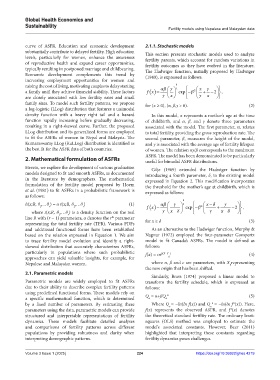Page 232 - GHES-3-1
P. 232
Global Health Economics and
Sustainability
Fertility models using Nepalese and Malaysian data
curve of ASFR. Education and economic development 2.1.1. Stochastic models
substantially contribute to delayed fertility. High education This section presents stochastic models used to analyze
levels, particularly for women, enhance the awareness fertility parents, which account for random variations in
of reproductive health and expand career opportunities, fertility outcomes as they have evolved in the literature.
typically resulting in postponed marriage and childbearing. The Hadwiger function, initially proposed by Hadwiger
Economic development complements this trend by (1940), is expressed as follows:
increasing employment opportunities for women and
raising the cost of living, motivating couples to delay starting
3 2 x
a family until they achieve financial stability. These factors fx exp 2 2 ,
are closely associated with low fertility rates and small x x
family sizes. To model such fertility patterns, we propose for (x ≥ 0), (α, β,γ > 0). (2)
a log-logistic (LLog) distribution that features a unimodal
density function with a heavy right tail and a hazard In this model, x represents a mother’s age at the time
function rapidly increasing before gradually decreasing, of childbirth, and α, β, and γ denote three parameters
resulting in a right-skewed curve. Further, the proposed associated with the model. The first parameter, α, relates
LLog distribution and its generalized forms are employed to total fertility, providing the gross reproduction rate. The
to fit the ASFRs of women in Nepal and Malaysia. The second parameter, β, measures the height of the model,
Kumaraswamy LLog (KuLLog) distribution is identified as and γ is associated with the average age of fertility lifespan
the best fit for the ASFR data of both countries. of women. The relation αγ/β corresponds to the maximum
ASFR. The model has been demonstrated to be particularly
2. Mathematical formulation of ASFRs useful for bimodal ASFR distributions.
Herein, we explore the development of various graduation Gilje (1969) extended the Hadwiger function by
models designed to fit and smooth ASFRs, as documented introducing a fourth parameter, δ, to the existing model
in the literature by demographers. The mathematical expressed in Equation 2. This modification incorporates
formulation of the fertility model proposed by Hoem the threshold for the mother’s age at childbirth, which is
et al. (1981) to fit ASFRs in a probabilistic framework is expressed as follows:
as follows:
3
h(x;R, θ ,…θ ) = α t(x;R, θ ,…θ ) (1)
2 x
2 r 2 r fx exp 2 2 ,
where t(x;R, θ ,…θ ) is a density function on the real x x
r
2
th
line R with (r − 1) parameters, α denotes the r parameter
representing the total fertility rate (TFR). Various PDFs for x ≥ δ (3)
and additional functional forms have been established As an alternative to the Hadwiger function, Murphy &
based on the relation expressed in Equation 1. We aim Nagnur (1972) employed the four-parameter Gompertz
to trace fertility model evolution and identify a right- model to fit Canada’s ASFRs. The model is defined as
skewed distribution that accurately characterizes ASFRs, follows:
particularly in populations where such probabilistic f(x) = cα β(X–X ) (4)
approaches can yield valuable insights, for example, for 0
Nepalese and Malaysian women. where α, β and c are parameters, with X representing
0
the new origin that has been shifted.
2.1. Parametric models
Similarly, Brass (1974) proposed a linear model to
Parametric models are widely employed to fit ASFRs transform the fertility schedule, which is expressed as
due to their ability to describe complex fertility patterns follows:
using predefined functional forms. These models rely on
a specific mathematical function, which is determined Q = α+βQ * (5)
x
x
by a fixed number of parameters. By estimating these Where Q = −ln(ln f(x)) and Q * = −ln(ln f*(x)). Here,
x
x
parameters using the data, parametric models can provide f(x) represents the observed ASFR, and f*(x) denotes
structured and interpretable representations of fertility the theoretical standard fertility rate. The ordinary least-
dynamics. These models facilitate detailed analyses squares (OLS) method was employed to estimate the
and comparisons of fertility patterns across different model’s associated constants. However, Beer (2011)
populations by providing robustness and clarity when highlighted that interpreting these constants regarding
interpreting demographic patterns. fertility dynamics poses challenges.
Volume 3 Issue 1 (2025) 224 https://doi.org/10.36922/ghes.4219

